[Editor’s Note: Mad Science Laboratory is pleased to excerpt below the Executive Summary from a DoD Biotechnologies for Health and Human Performance Council (BHPC) study group report entitled, Cyborg Soldier 2050: Human/Machine Fusion and the Implications for the Future of the DOD. This report, authored by Peter Emanuel, Scott Walper, Diane DiEuliis, Natalie Klein, James B. Petro, and James Giordano (proclaimed Mad Scientist); and published by the U.S. Army Combat Capabilities Development Command Chemical Biological Center (CCDC CBC), culminates a year-long assessment to forecast and evaluate the military implications of machines that are physically integrated with the human body to augment and enhance human performance over the next 30 years. This report summarizes this assessment and findings; identifies four potential military-use cases for new technologies in this area; and makes seven recommendations on how the U.S. should proceed regarding human/machine enhancement technologies. Enjoy!]
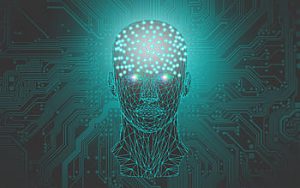 A DoD BHPC study group surveyed a wide range of current and emerging technologies relevant to assisting and augmenting human performance in many domains. The team used this information to develop a series of vignettes as case studies for discussion and analysis including feasibility; military application; and ethical, legal, and social implication (ELSI) considerations.
A DoD BHPC study group surveyed a wide range of current and emerging technologies relevant to assisting and augmenting human performance in many domains. The team used this information to develop a series of vignettes as case studies for discussion and analysis including feasibility; military application; and ethical, legal, and social implication (ELSI) considerations.
Ultimately, the team selected four vignettes as being technically feasible by 2050 or earlier. The following vignettes are relevant to military needs and offer capabilities beyond current military systems:
-
 ocular enhancements to imaging, sight, and situational awareness;
ocular enhancements to imaging, sight, and situational awareness;- restoration and programmed muscular control through an optogenetic bodysuit
sensor web; - auditory enhancement for communication and protection; and
- direct neural enhancement of the human brain for two-way data transfer.
Although each of these technologies will offer the potential to incrementally enhance performance beyond the normal human baseline, the BHPC study group analysis suggested that the development of direct neural enhancements of the human brain for two-way data transfer would create a revolutionary advancement in future military capabilities. This technology is predicted to facilitate read/write capability between humans and machines and between humans through brain-to-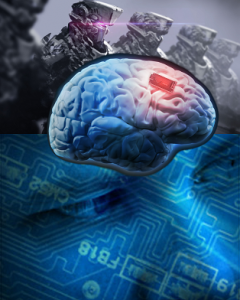 brain interactions. These interactions would allow warfighters direct communication with unmanned and autonomous systems, as well as with other humans, to optimize command and control systems and operations. The potential for direct data exchange between human neural networks and microelectronic systems could revolutionize tactical warfighter communications, speed the transfer of knowledge throughout the chain of command, and ultimately dispel the “fog” of war. Direct neural enhancement of the human brain through neuro-silica interfaces could improve target acquisition and engagement and accelerate defensive and offensive systems.
brain interactions. These interactions would allow warfighters direct communication with unmanned and autonomous systems, as well as with other humans, to optimize command and control systems and operations. The potential for direct data exchange between human neural networks and microelectronic systems could revolutionize tactical warfighter communications, speed the transfer of knowledge throughout the chain of command, and ultimately dispel the “fog” of war. Direct neural enhancement of the human brain through neuro-silica interfaces could improve target acquisition and engagement and accelerate defensive and offensive systems.
Although the control of military hardware, enhanced situational awareness, and faster data assimilation afforded by direct neural control would fundamentally alter the battlefield by the year 2050, the other three cyborg technologies are also likely to be adopted in some form by warfighters and civil society. The BHPC study group predicted that human/machine enhancement technologies will 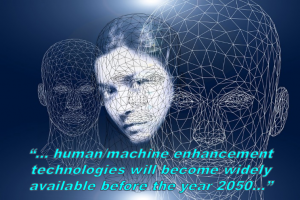 become widely available before the year 2050 and will steadily mature, largely driven by civilian demand and a robust bio-economy that is at its earliest stages of development in today’s global market. The global healthcare market will
become widely available before the year 2050 and will steadily mature, largely driven by civilian demand and a robust bio-economy that is at its earliest stages of development in today’s global market. The global healthcare market will
fuel human/machine enhancement technologies primarily to augment the loss of functionality from injury or disease, and defense applications will likely not drive the market in its later stages. The BHPC study group anticipated that the gradual introduction of beneficial restorative cyborg technologies will, to an extent, acclimatize the population to their use.
The BHPC study group projected that introduction of augmented human beings into the general population, DOD active duty personnel, and near-peer competitors will accelerate in the years following 2050 and will lead to imbalances, inequalities, and inequities in established legal, security, and ethical frameworks. Each of these technologies will afford some level of performance improvement to end users, which will widen the performance gap between enhanced and unenhanced individuals and teams. The BHPC study group analyzed case studies and posed a series of questions to drive its assessment of the impact to DOD programs, policies, and operations. The following are the resulting recommendations (not listed in order of priority):
1. DOD personnel must conduct global assessments of societal awareness and perceptions of human/machine enhancement technologies. A generalized perception exists in the United States that our adversaries are more likely to adopt technologies that U.S. populations are reluctant or unwilling to field  because of ethical concerns. However, the attitudes of our adversaries toward these technologies have never been verified. Societal apprehension following the introduction of new technologies can lead to unanticipated political barriers and slow domestic adoption, irrespective of value or realistic risk. Assessment of global attitudes will predict where it may be difficult to introduce new technologies because of sociopolitical barriers to adoption and when adversarial adoption of offset technologies may likely be more readily accepted.
because of ethical concerns. However, the attitudes of our adversaries toward these technologies have never been verified. Societal apprehension following the introduction of new technologies can lead to unanticipated political barriers and slow domestic adoption, irrespective of value or realistic risk. Assessment of global attitudes will predict where it may be difficult to introduce new technologies because of sociopolitical barriers to adoption and when adversarial adoption of offset technologies may likely be more readily accepted.
2. U.S. leadership should use existing and newly developed forums (e.g., NATO) to discuss impacts to interoperability with allied partners as we
approach the year 2050. 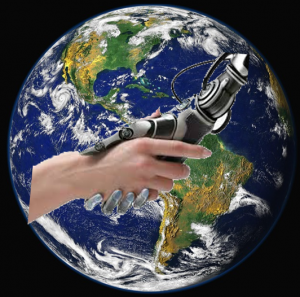
This will help develop policies and practices that will maximize interoperability of forces. The rapid development pace of cyborg technologies has implications for interoperability of military forces. The DOD requirement to maintain interoperability with allied partners within NATO and other global alliance frameworks warrants the undertaking of efforts to align cyborg assets with existing allied partnership doctrine.
3. DOD should invest in the development of dynamic legal, security, and ethical frameworks under its control that anticipate emerging technologies.  The current legal, security, and ethical frameworks are insufficient because of the speed at which these technologies are developing in the United States and other nations around the world (allied and adversarial). Therefore, the DOD should support the development of forward-leaning policies (internal and external) that protect individual privacy, sustain security, and manage personal and organizational risk, while maximizing defined benefits to the United States and its allies and assets. Because operationalization of technology for national security is at the core of the DOD mission, these frameworks should be structured to be agile and responsive to new technologies developed within the United States or elsewhere.
The current legal, security, and ethical frameworks are insufficient because of the speed at which these technologies are developing in the United States and other nations around the world (allied and adversarial). Therefore, the DOD should support the development of forward-leaning policies (internal and external) that protect individual privacy, sustain security, and manage personal and organizational risk, while maximizing defined benefits to the United States and its allies and assets. Because operationalization of technology for national security is at the core of the DOD mission, these frameworks should be structured to be agile and responsive to new technologies developed within the United States or elsewhere.
4. Efforts should be undertaken to reverse negative cultural narratives of enhancement technologies. Across popular social and open-source media, literature, and film, the use of machines to enhance the physical condition of the human species has received a distorted and dystopian narrative in the name of  entertainment. A more realistic and balanced (if not more positive) narrative, along with transparency in the government’s approach to technology adoption, will serve to better educate the public, mitigate societal apprehensions, and remove barriers to productive adoption of these new technologies.* A more informed public will also help illuminate valid social concerns, such as those surrounding privacy, so that DOD personnel can develop mitigation strategies, whenever possible. Although not intrinsically a DOD mission, defense leadership should understand that negative public and social perceptions will need to be overcome, if these technologies are to be fielded.
entertainment. A more realistic and balanced (if not more positive) narrative, along with transparency in the government’s approach to technology adoption, will serve to better educate the public, mitigate societal apprehensions, and remove barriers to productive adoption of these new technologies.* A more informed public will also help illuminate valid social concerns, such as those surrounding privacy, so that DOD personnel can develop mitigation strategies, whenever possible. Although not intrinsically a DOD mission, defense leadership should understand that negative public and social perceptions will need to be overcome, if these technologies are to be fielded.
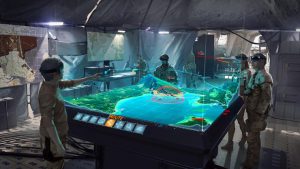
5. DOD personnel should conduct tabletop wargames and targeted threat assessments to determine the doctrine and tactics of allied and adversarial forces. Wargames are an established mechanism to gauge the impact of asymmetric technologies on tactics, techniques, and procedures. Tabletop exercises exploring varied scenarios of the integration and use of human/machine technologies by the United States or its adversaries will predict offset advantages, identify NATO and other allied organizational interoperability friction points, and inform senior military strategists and science and technology investors. DOD personnel should support these efforts using targeted intelligence assessments of this emerging field.
 6. The U.S. Government should support efforts to establish a whole-of-nation approach to human/machine enhancement technologies versus a whole-of-government approach. Federal and commercial investments in these areas are uncoordinated and are being outpaced by Chinese research and development efforts, which could result in a loss of U.S. dominance in human/machine enhancement technologies within the projected timeframe of this study. Near-peer dominance in the commercial sector will place U.S. interests in the defense sector at a disadvantage and could lead to an offset disadvantage in the realm of human/machine enhancement by the year 2050. A national effort to sustain U.S. dominance in cyborg technologies is in the best interests of the DOD and the nation.
6. The U.S. Government should support efforts to establish a whole-of-nation approach to human/machine enhancement technologies versus a whole-of-government approach. Federal and commercial investments in these areas are uncoordinated and are being outpaced by Chinese research and development efforts, which could result in a loss of U.S. dominance in human/machine enhancement technologies within the projected timeframe of this study. Near-peer dominance in the commercial sector will place U.S. interests in the defense sector at a disadvantage and could lead to an offset disadvantage in the realm of human/machine enhancement by the year 2050. A national effort to sustain U.S. dominance in cyborg technologies is in the best interests of the DOD and the nation.
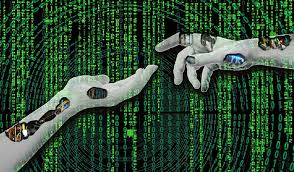 7. The DOD should support foundational research to validate human/ machine fusion technologies before fielding them and to track the long-term safety and impact on individuals and groups. The benefits afforded by human/machine fusions will be significant and will have positive quality-of-life impacts on humankind through the restoration of any functionality lost due to illness or injury. The military community will also see capability opportunities that will impact operations and training. As these technologies evolve, it is vital that the scientific and engineering communities move cautiously to maximize their potential and focus on the safety of our society. Commensurate investments in these areas will work to mitigate the misuse or unintended consequences of these technologies.
7. The DOD should support foundational research to validate human/ machine fusion technologies before fielding them and to track the long-term safety and impact on individuals and groups. The benefits afforded by human/machine fusions will be significant and will have positive quality-of-life impacts on humankind through the restoration of any functionality lost due to illness or injury. The military community will also see capability opportunities that will impact operations and training. As these technologies evolve, it is vital that the scientific and engineering communities move cautiously to maximize their potential and focus on the safety of our society. Commensurate investments in these areas will work to mitigate the misuse or unintended consequences of these technologies.

If you enjoyed this post, please see:
Cyborg Soldier 2050: Human/Machine Fusion and the Implications for the Future of the DOD complete report here.
… read the following related MadSci Lab blog posts:
-
- Linking Brains to Machines, and Use of Neurotechnology to the Cultural and Ethical Perspectives of the Current Global Stage, by Mr. Joseph DeFranco and Dr. James Giordano.
-
- Connected Warfare by COL James K. Greer (USA-Ret.)
… watch Dr. Alexander Kott‘s presentation The Network is the Robot, presented at the Mad Scientist Robotics, Artificial Intelligence, & Autonomy: Visioning Multi Domain Battle in 2030-2050 Conference, at the Georgia Tech Research Institute, 8-9 March 2017, in Atlanta, Georgia.
… and see Hank Greely‘s presentation on Future Legal and Ethical Implications of Bio Technology from the Mad Scientist Bio Convergence and Soldier 2050 Conference, at SRI International, 8-9 March 2018 in Menlo Park, California.
Disclaimer: The findings in this report are not an official policy or position of the Department of the Army, the National Defense University, the Department of Defense, or the U.S. Government.
* Wurzman R.; Yaden D.; Giordano J. Neuroscience Fiction as Eidola: Social Reflection and Neuroethical Obligations in Depictions of Neuroscience in Film. Camb Q Health Care Ethics-Neuroethics Now 2017, 26 (2), 292-312.

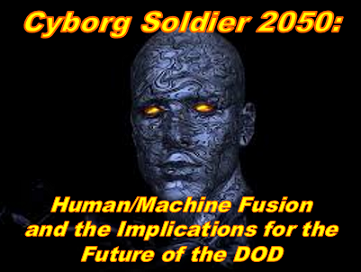


As the discussion on Cyborg Soldier of 2050 continues; who will be the tested sample population for this study. Our Government has historically been challenged with providing quality mental health and medical care for our fallen Soldiers and currently these issues are still a topic of discussion/crisis. What are the future plans to provide care, if any, for the Cyborg Soldiers of 2050; when those of 2019 and earlier are still suffering from acts of war?